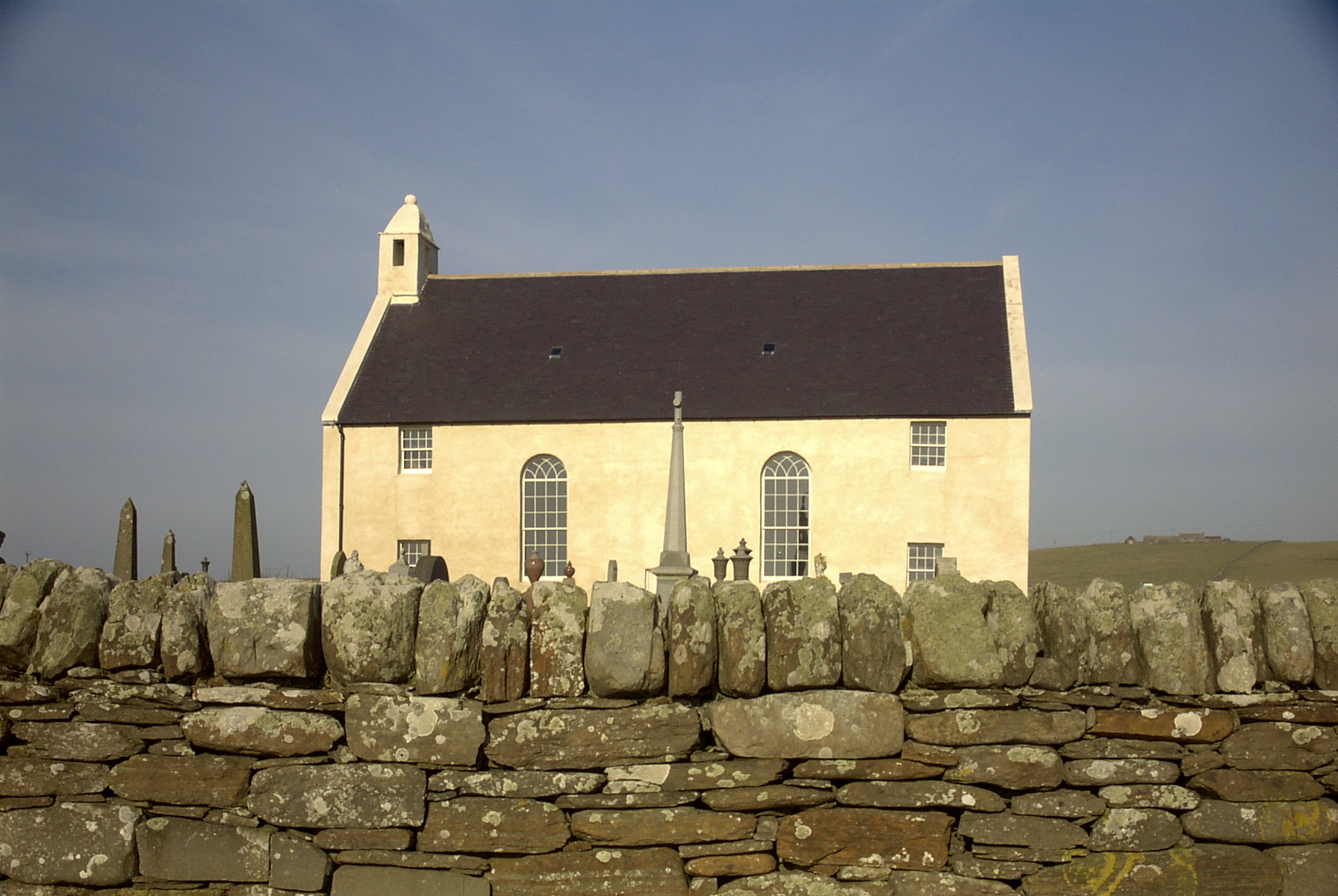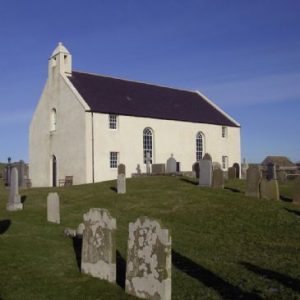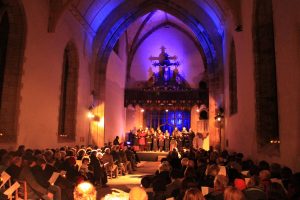by Tristram Clarke*
The Scottish Redundant Churches Trust (SRCT) is a charity safeguarding Scotland’s ecclesiastical heritage for current and future generations, and promoting its understanding and enjoyment.

St Peter’s, Sandwick after restoration. Credits: SRCT
We save historic churches at risk, and work with communities to secure the future of their churches through expert conservation and creative regeneration. We own seven historic churches in Scotland, all of national importance and outstanding heritage value.
Buildings in our care remain as places of worship: conserving their cultural significance and sustaining their original purpose through occasional worship. Alongside this, additional appropriate uses are developed to create new opportunities and engage new audiences. This brings renewed life to our churches, ensuring that buildings benefit everyone, irrespective of belief or faith. Our stewardship aims to ensure that tensions between conservation and reuse or extended use are balanced, in order to achieve the best outcome for Scotland’s heritage and people.
We work in partnership with local people: consulting and involving them, and inviting them to play an active role in caring for their built environment. Together, we conserve nationally important historic buildings, and create a strong social, cultural and economic asset in the area.
However, as dozens of churches cease to be used for worship each year, and funding becomes increasingly scarce, the challenge of preserving the best for the future has never been harder.
Of course it is widely recognised that the biggest single factor causing churches to fall out of use, a trend that is occurring at different rates across the western world, is the overall decline in church attendance. Another key factor in Scotland is its peculiarly complex church history, which is perhaps more convoluted than in any other part of the British Isles. More than 450 years of the evolution of the Church of Scotland and dissenting denominations since the Reformation have bequeathed a rich legacy of large numbers of fine churches throughout Scotland. For example, during the eighteenth century several small sects were formed by splits from the Church of Scotland. In 1843 the well-named Disruption led to the formation of the Free Church and the energetic construction over the next few decades of hundreds of churches by its congregations. Since then re-unions with the established church have tended to leave the Church of Scotland over-provided with churches.
The continuing presence of the Roman Catholic Church and Scottish Episcopal Church, the Baptist and Congregational Churches, and others besides, adds more colour to the spectrum of church buildings in Scotland. While some denominations have suffered from falling attendances, others have remained resilient or even grown, so the picture is not one of uniform decline. In 2009 a report by the Historic Environment Advisory Council for Scotland (HEACS) alluded to the ‘richness, diversity and complexity of Scotland’s ecclesiastical heritage’.

St Peter’s, Sandwick. Credits: SRCT
Despite the Council’s recommendations for action, the problems of redundancy of church heritage have yet to be addressed strategically in Scotland. The Historic Environment Strategy for Scotland, Our Place In Time, published in 2014, examines the built heritage in general. While it does not address the unique difficulties of church heritage, it has set the framework for how this nation’s historic built environment will be cared for collectively during the next 10 years.
What has been the SRCT’s approach? We were formed in 1996 as an independent charitable organisation because the need for a Scotland-wide body to take redundant places of worship of high heritage merit into care was recognised. At the outset, a curatorial approach was taken: the most significant examples of former places of worship of all faiths and denominations would be acquired and conserved intact as museum pieces and ‘saved for the nation’. We considered that it was enough to save the fabric, allow visitors to enjoy the conserved building, and permit occasional suitable uses to assist with running costs. This ‘conserve as found’ model, was employed to great effect in the Trust’s first project at St Peter’s Kirk at Sandwick on the mainland of Orkney.
The exemplary restoration of this spectacularly located remote rural church in 2002-3 won awards from Europa Nostra, the RIBA and the Scottish Civic Trust. With no electricity, water, or heating, uses were envisaged as ‘light-touch’, and since then the building has been open to visitors, and occasional services and musical events have taken place.
During the period 1998-2013, the Trust acquired seven churches, all but one being former Church of Scotland parish churches. Most of these date from between the eighteenth and early nineteenth century, although the majority incorporate pre-Reformation fabric. Three of them stand in rural isolation. The country kirks at Kildrummy in Aberdeenshire, Benholm in Aberdeenshire (formerly Kincardineshire), and Tibbermore near Perth, had little or no settlement nearby and served congregations whose members lived and worked on the surrounding farmland. The scattered nature of communities can have direct consequences for local participation in the present day, but demographic changes can change the balance. Pettinain Church, near Carstairs in Lanarkshire, stands on the edge of a scattered village community which has actually been expanding.
Only the East Church in Cromarty, Ross-shire, is situated in a small town, and St Margaret’s, Braemar, our most recent acquisition in 2013, stands in the heart of the well-known Deeside village.

East Church, Cromarty, after restoration. Credits: SRCT
Looking back to its foundation in 1996, the Trust’s initial ambitions of acquiring and conserving one church per year, appear unrealistic and naive. Yet at the time it seemed achievable: the arrival of the Heritage Lottery Fund in 1994 had transformed the heritage funding scene and, for Scotland’s most significant historic buildings, grants were readily available. It was enough to make the case for a church’s outstanding architectural and/or historic merit, because it was widely accepted that these buildings deserved to be preserved.
Fast-forward 20 years, and the picture could not be more different. Heritage merit alone no longer justifies grant: buildings must deliver quantifiable social and economic benefit and be sustainable. Competition for funding is fierce, and demand has never been greater. The Trust has therefore had to adapt its approach, both towards those churches already in its portfolio, and to those being considered for acquisition.
For existing churches in care, a more entrepreneurial approach is being developed. While this is driven in part by the need to increase income-generation – striving towards the ultimate goal of each church being self-funding – the motivation also stems from a desire to increase use and access by a greater number and diversity of people. By being open to new approaches and possibilities in the way the Trust’s churches are experienced by people, we have seen the East Church in Cromarty used to record the debut album of award-winning all-women fiddle group RANT; Tibbermore Church used for the filming of hit US TV drama ‘Outlander’; and, most recently and in partnership with the Churches Conservation Trust, ‘Champing’ (camping in churches) introduced at St Peter’s Kirk.
Our current project at St Margaret’s Braemar is also a significant departure from the Trust’s traditional ‘conserve as found’ model for its conservation projects. This £2.5million project, part of a wider initiative to develop the area’s important visitor economy, will see the A-listed and ‘at-risk’ former Episcopal church (Sir J Ninian Comper, 1899-1907) regenerated as a performance and interpretation space. Worship will, however, remain as a small but highly significant element of the use-mix for this exceptional building, enabling the building’s spiritual origins to continue to be experienced and enjoyed.

St Margaret’s, Braemar, performance. Credit SRCT
St Margaret’s Braemar also represents a further significant development for the SRCT – that of partnership working on a scale not previously attempted. The project is being undertaken jointly with a locally-based trust that will take on the operation of the building on completion, running it for the benefit of the community and itself working in partnership with a network of other venues and visitor attractions in the area. The SRCT recognises that this is the way forward for the organisation, particularly in tackling the growing number of large-scale nationally important churches becoming redundant. The prospect is both exciting and daunting – a testing challenge of our capacity to play a key role in the future of Scotland’s cultural heritage.
During the past two decades Scotland’s ecclesiastical heritage landscape has changed immeasurably. Significant issues include: a marked increase in the threat to major landmark churches; a trend in the purchase of rural churches by community-led groups; and the loss of fixtures, fittings and stained glass through closure or re-ordering of interiors. These and other factors create new and different needs in addition to those which led to the creation of the Trust. Meeting these needs requires the organisation to adapt, grow and work in partnership with others.
We do this because we recognise the Trust’s role in the wider historic environment context, rather than as an organisation focused on a single aspect of the heritage. We need to ensure that our work plays its part in the delivery of the Historic Environment Strategy for Scotland. We are also only too aware that to fit ourselves to meet present and future challenges, the ‘Redundant’ in our name is now itself redundant.
* Tristram Clarke has been a trustee of the Scottish Redundant Churches Trust since it was established in 1996, and is presently its acting Chairman. As part of his general interest in the history of Scottish churches, he has published various articles, including on his special interest in the history of the Scottish Episcopal Church.





Follow us: